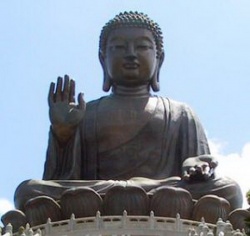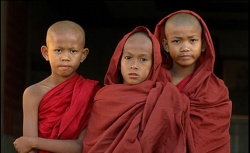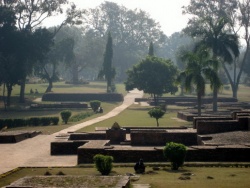Precepts for bhiksu and bhiksuni
-Parajika: (4 precepts for monk; 8 precepts for nun) Breaking these 4 precepts: killing, stealing, sexual misconduct and lying result in banning from Buddhism -Sanghavasesa:
(13 precepts for monk; 17 precepts for nun) Breaking these rules is compared to having damaged one's five sense organs -Nissaggya: (120 precepts for monk; 208 precepts for nun) Breaking one of these rules results in hell after death -Patidesaniya: (4 precepts of monk, 18 precepts for nun) Breaking one of these rules can be redeemed. Repentance is allowed by confessing to another monk -Dukkata: (100 precepts for monk; 100 precepts for nun) There are so many precepts; most are trivial ones that need to be observed every hour and minute of the day.
The Ten important ones are:
1. Not to kill for pleasure.
2. Not to steal or rob.
3. For monk: Not to have sex with women. For
lay disciple: Not to commit adultery.
4. Not to lie with intention.
5. Not to buy or sell alcohol.
6. Not to talk about others' errors.
7. Not to praise oneself and put down others.
8. Not to be difficult in giving out the Dharma and
insult the one who ask for it.
9. Not to be angry and refuse to listen to advice.
10. Not to offend the Triple Jewels.
Breaking one of these ten rules is a serious offense.
Breaking one of the forty-nine minor rules is pardonable.
(Revelation of Magic Principles Governing Bodhi Heart Bodhisattva Precepts) In central India country of Magadha, Rajagraha City, at the Nalanda Forest of Bamboos monastery, there was a Tripitaka monk named Dubaca, or Subhakarasimha. He was from a generous and noble family of Ksatrya lineage, an expert in the doctrine of the Great Vehicle. When he came to China, he discussed the Great Vehicle in depth and analyzed its essential points with Zen master Ji`ng Xi'an at the monastery Hu`i Shan in Co`ng Yue. The dialogue of Dubaca had opened the people's eyes and converted them to Buddhism. His exposition contains the requirements to receive the Revelation of Magic Principles governing the Bodhi Heart
Bodhisattva Precepts of the Secret Doctrine, which has been transferred up to this day. The following is a general outline.
1. The subject on paying homage.
2. The subject on offerings.
3. The subject on repentance.
4. The subject on taking refuge with the Buddha.
5. The subject on making the Bodhi Vow (Vow to become
Buddha).
6. The subject on protection from dangers.
7. The subject on respectfully inviting the master.
8. The subject on the supernatural doctrine. (Three groups of precepts on cultivation of purity: precepts of rites with its 10 precepts to avoid cruel actions, precepts on good action and precepts on being beneficial to others).
9. The subject of keeping the precepts.
10. The subject of cultivation of the four salvations.
11. Ten Major precepts (just for Secret Buddhism).
Although the practitioner has received the Bodhisattva precepts, it is better that he also receives the precept and doctrine on the awakening of the heart of purity and the passionless nature of Buddhas to enter the gate of samadhi.
This doctrine on precepts is itself the secret Dharani that Buddhas has used to come to the sea of “All Knowing Mind”. It has been kept secret so far. The following are some of the essential revelations for the person that has affinity with the secret doctrine.
First Dharani: (......)
Reciting this Dharani 3 times allows entrance to the forbidden peaceful realm and to listen to other secret doctrine and all the rules governing the serenity of Bodhisattva.
Second Dharani: (......)
Reciting this Dharani 3 times 108 (324) allows one to make the vow to reach enlightenment and to become Buddha without fail.
Third Dharani: (......)
Reciting this Dharani 3 times 108 allows one to get all the precepts and the wisdom of Buddha.
Fourth Dharani: (......)
Reciting this Dharani 3 times 108 allows one to attain the rank of Abhisekha master. He will be able to understand the secret doctrines. He will be able to receive and practice all the subjects on stillness.
(Subhakarasimha Tripitaka on Receiving the Precepts of Redemption and Essential on Meditation)
Mandala Mirror Chunti Mudra
First stage: Recite the Dharanis for 100 days (each session 108 times).
Second stage: Recite the Dharanis for one year (each session 5x108=540 times).
Third stage: Recite the Dharanis for 3 years 3 months 3 days (each session 5x108= 540 times). On the 15th day of the Lunar month, stand in front of Buddha’s statue and a mirror that has never been used, form the Cundi Mudra and recite 108 times the Five Dharanis.
Next, sit in the full or half lotus position in front of the “Mandala mirror” and silently pray as dictated by the rituals of Secret Buddhism.
(Buddha, Doctrine, Sangha)
1. I sincerely pay homage to Mahavairocana Buddha (the Creator) (1 bow)
2. To the blissful Precious Body of Vairocana (1 bow)
3. To all the Buddha's Incarnate Bodies (1 bow)
4. To all the miraculous Dharani Doctrine (1 bow)
5. To all the Bodhisattvas having both Blessings and Wisdom as numerous as the waters in the ocean (1 bow)
Form the Cundi Mudra and silently recite the full Dharani 108 times:
OM LAM – OM XILAM – OM MANI PADME HUM – OM ZHI LI, ZHU LI, CUNDI SVAHA – BO LAM
1. Prayer for a Peaceful Rebirth
To the Triple Jewels and the majestic Deities who support the one who prays, the Bodhisattvas and Shravaka, Brahma Indra Tchaturmaharaja, the eight fold division of Deva Naga, the Dharma protector, the King of the Deities, and to all compassionate Gods, please acknowledge that as a disciple, I sincerely recite Dharani and wish to offer these merits to all the souls that have died from injustice or from sudden death, and to those who wandered in the mountain and forest or desolated villages to be liberated and reborn in the Pure Land of the Buddhas.
2. Secondary Prayer
As a disciple, I pray to eliminate bad karma. I pray to banish all evil spirits, cruel ghosts and Demons, all attachments, separations illusions and delusions, all the spells, diseases and accidents.
3. General prayer
I pray for safety and peace in all four seasons, for abundance in the world, for more blessing and intelligence and for the fulfillment of my wishes. Namo PUNYATARA Bodhisattva (Chinese: Gong De Lin Bodhisattva- the Bodhisattva whose merits are as numerous as the trees in the forest) (Reciting 3 times, bow down 3 times)
In Meditation
Research on meditation from different religions, schools of philosophies, or from various sects, reveals an exciting, but difficult subject that surpasses the scope of this book. However, the main methods of meditation of the Great Vehicle can be summarized in the following seven groups. 1. Meditation by observation of the breath According to the Oneness Principle of the Heart and Breath, if we can control the breath, we can harmonize the heart.
The practice on controlled breathing is the best method to enter Samadhi. The most common method is counting the breath, following or holding one's breath. The first method is safer and easier. Zen masters strongly recommend this method, which was practiced over centuries. With this method one does not have to depend on the guidance of a Guru if he understands basic breathing techniques and principles of Yoga. Monk Zhi`Kai, the first founder of the T’ien T’ai sect of China explained the “counting and following” breathing technique in his famous book “The Gate to the Six Wonderful Doctrines” (or Six Wonderful Ways to Enlightenment).
2. Onepointedness Yoga
This is the most important of the five spiritual meditation practices mentioned above. Many Buddhists practiced the doctrine of “The Four Countless Virtues” to nurture good thoughts for all, and to reduce conflicts that cause misfortunes between men. This practice must come first before one attempts any other methods. In Tibet, the hymns on “The Four Countless Virtues” are recited and meditated upon prior to any practice. The lack of spiritual preparation, training on good thoughts and adoration, will not bring any good results for any kind of meditation.
It can even lead to the wrong way. Practitioners who do not achieve enlightenment after a long period of meditation will find out that they are lacking in spiritual cultivation. They will then return to the basic practice of “The Four Countless Virtues”, the Bodhisattva’s Vow, and the use of prayers, prostration and adoration to complement their practice. This is the basic practice for anyone who is serious in reaching enlightenment. .
Self Realization Yoga This is the so-called undemanding meditation practice of the Zen and Mahamudra sects. It is a meditation that has nothing to focus on. It is the sudden and wonderful response of the mind, the essence of all doctrines. For the ones who have not yet entered its door, this is the most difficult way. But for those who have entered, it is the easiest way. All other practices are only preparations for this one. The essence of this practice is to gain insight into the true nature of the mind, to realize the nature of the mind, or to at least catch a glimpse of it.
Once it is known, one can easily identify with it at any time and place. In action or in quietude, the consciousness of extreme perfection is ever shining. Even though there is still a long way to go following the realization of self, the sages of Buddhism considered this first realization most important. Once a practitioner enters the “Gateless Gate”, meditation is no longer a practice or effort but is as natural as life itself. To obtain this “Gateless Gate” stage we must diligently practice this meditation by following the way of Zen, or the way of Mahamudra sect (Tibetan Book of the Great Liberation and Tibetan Book Yoga and Secret Doctrine Book, Volume II of Evans-Wentz).





